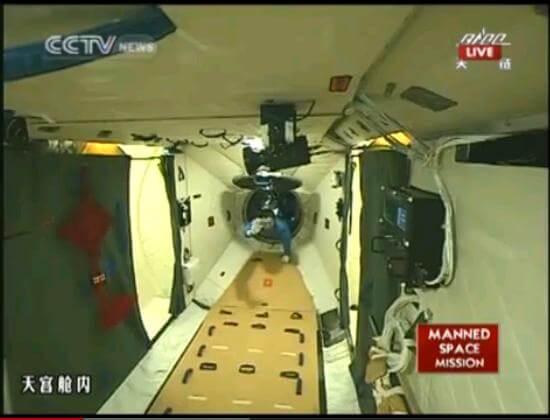In doing so, China recorded another achievement. It is the third country to make a manned connection with another spacecraft, after the USA and Russia.

The crew of the Chinese Shenzhou 9 spacecraft at the tiny Tiangong 1 space laboratory. The three techonauts entered the station, which had been unmanned until now, for the first time. In doing so, China recorded another achievement. It is the third country to make a manned connection with another spacecraft, after the USA and Russia. Spacecraft commander Jing Haifeng led the crew into the laboratory, first Liu Wang and then Liu Yang - the first Chinese woman in space.
The Shenzhou crew completed the docking on Monday morning (06:00 GMT). The spaceships were then in orbit at an altitude of 343 kilometers above the Earth. The docking was broadcast live on Chinese television.
The docking itself was performed automatically and monitored by the control center. Manual docking by crew members will be performed later in the mission.
The astronauts will live and work in the module for several days and perform medical experiments as well as studies of live butterflies, butterfly eggs and pupae.
This first mission is just the beginning of China's preparations for placing a manned space station, which will be built by 2020. The new space station will weigh about 60 tons. It is about one-sixth the size of the International Space Station and is only slightly smaller than the American space station Skylab which was active in the XNUMXs.
Tiangong-1 is only an experimental model weighing 8.5 tons and is designed to stay in space for about two years and support a crew of three astronauts for short periods of time. Another mission is expected to visit the station - Shenzhou 10.
China cooperated only to a limited extent with other countries and it was not allowed to participate in the International Space Station mainly due to the opposition of the USA.
China launched the first Techonaut into space in 2003, in another mission two humans were launched in 2005, and three in 2008, a mission in which China's first spacewalk was also performed.
Yesterday's docking and entry of the technauts, including the first Chinese woman to Tiangong, coincidentally coincides with the anniversary of the launch of the first American astronaut Sally Ride on the STS-7 flight in 1983.

4 תגובות
We can too but we have no vision and desire!!!!!!!!
The Chinese are not what they used to be and now they are proving it
It is first of all for themselves.
Written on an iPad made in China
Instead of investing so much money in life support systems and cumbersome systems that will allow humans to live in space, it would be much better in my opinion to invest in the field of robotics and artificial intelligence for space missions and planetary exploration.
Well done to them, but I'm not sure I would be ready to walk around in space inside something made in China..